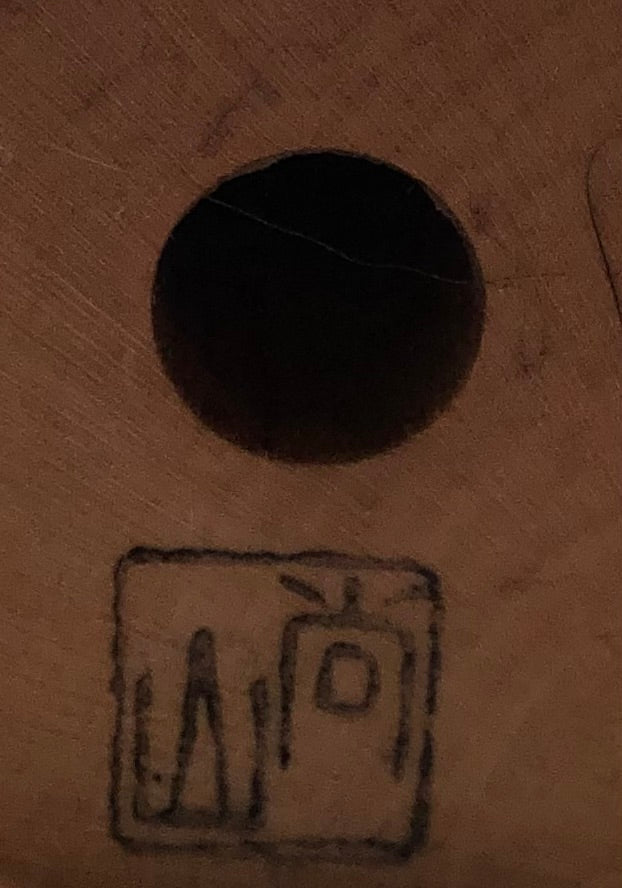



Vintage Sosaku Kokeshi entitled: “Osone / Mai | Dancer” by Shouzan, Shido (1932-1995)
Dimensions: 15-1/4” h
Shouzan-san is considered by Kokeshi collectors and critics alike to be the most influential artist in the world of Sosaku Kokeshi doll-making. His dolls have won various awards since 1958, including the “Doll exhibition-retro Award”, and the Prime Minister’s Award. He served as a judge of the All Japan Kokeshi Contest from 1970-1976. Shouzan, as opposed to other Kokeshi craftspersons, published a book entitled: Kizin Kasho, citing examples of his award-winning Kokeshi. The Kokeshi, entitled: “Osono | Dancer”, sometimes known as Mai, is a different color version of the image in the award-winning book entitled: Kokeshi: Wooden Treasures of Japan, published in 2005.
This is an alternative version of the Kokeshi named Osone. The uniqueness focuses on the color and graphic details of the Obi, which has chrysanthemum petals in gold, over a background of purple, and the rust-colored undergarment. This is an exceptionally beautiful, elegant, tall, and slender doll made of Birchwood, (Kabanoki), bringing forth the best use of complex geometry to create these unique Japanese elements. This doll has a traditional black hairstyle with one different approach to the “Mage”, in that it appears almost like a hair ornament as opposed to a top knot. The doll has the artist’s impressed Honko on the bottom of the doll, which was used on forthcoming dolls with a graphic placed in a box.
The piece was published in the 2022 research publication entitled: Sosaku Kokeshi: Celebrating the Major Artists of the Creative Movement (https://mingeiarts.com/products/sosaku-kokeshi-celebrating-the-major-artists-of-the-creative-movement). For more information on this artist go to the following link: https://mingeiarts.com/collections/artisan-woodworker-shido-shozan-1932-1995.
Condition: Superb lathe-turned creation and size, for it is outstanding, excellent, impressive, and beautiful. No chips, cracks, breaks, missing pieces, or restoration; is very stable, and retains its original details and finish. The piece meets all the standards of the vintage collectible Sosaku Kokeshi by Shouzan, Shido.

Artisan
Woodworker: Shido, Shouzan
1932-1995
Biographical History:
Shouzan began making Sosaku Kokeshi in 1959, soon after he graduated from Chuo University with a law degree. He is considered by Kokeshi collectors and critics alike to be arguably the most influential artist in the world of Sosaku Kokeshi doll-making. Shido-san’s main focus was depicting unadorned Northern girls in the traditional “Mino”, or Snow Coat, but he also produced tall, thin dolls, which were sparsely decorated. His keen sense of design, minimal use of color, and simple elegant shapes set him apart from his peers, making him one of the most collectible artists emerging from the creative period of the ‘60s winning various awards since 1961. He served as a judge of the All Japan Kokeshi Contest from 1970 to 1976. During that time Shozan published a book entitled Kizin Kasho comprising examples of his award-winning Kokeshi. His dolls have been collected and exhibited worldwide and winner of the Prime Minister’s Award, among many other awards.
Collector's note – descriptive qualities, standard characteristics & ornamentation styles:
Shito-san loved studying the use of combining different types of wood to gain the desired effect and to give dimension to his pieces. He also enjoyed creating slender, tall dolls to support the fact that they resemble the tall, thin trees seen throughout Japan. He incorporated a repetitive textural pattern called ‘Harmonic Chatter work’ to enhance the natural qualities of the wood in many of his works. He particularly enjoyed the textural qualities of ‘Chattering’ on the rain/snow coat, (Minomushi), which is a favorite theme, executed with minimal painted ornamentation, with an emphasis on the natural wood. In general, it is said that Japanese culture is one of modesty and humility. Occasionally saw different types of headdresses, one of which he called a ‘Tsunokakushi’, which is a wide headdress or hood, that covered elaborate hairstyles. We are told that the Japanese people regulate their behavior and response by reading faces and the eyes of others. Here, as well as elsewhere, you will see many examples of different characteristics of the eye's expressions. His most famous doll, which was considered a favorite was called “Mai”, a dancer, which was an elegant and slender doll with a beautifully formed Kimono focusing on traditional hair design (Mage) with an emphasis on a brightly colored “obi” which brings forth the best use of complex geometry to create traditional Japanese clothing elements which were created in 1970.
Shito-san was a prolific artist/woodworker of Kokeshi dolls some of which were whimsical, some focusing on calligraphy citing haiku (poems). We additionally see unusual subjects focused on Zen Buddhism and figures of Daruma, (Bodhidharma) of which most were made in a “roly-poly” type figure seen throughout festivals in Japan.
Explore & Learn More about Woodworker: Shido, Shouzan